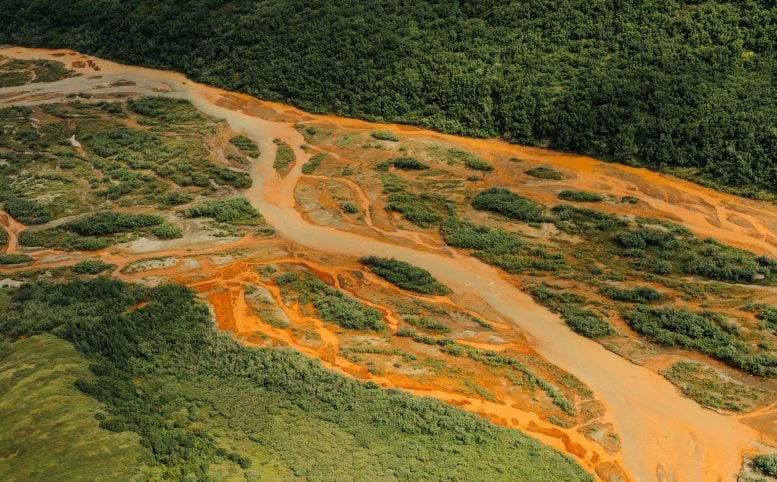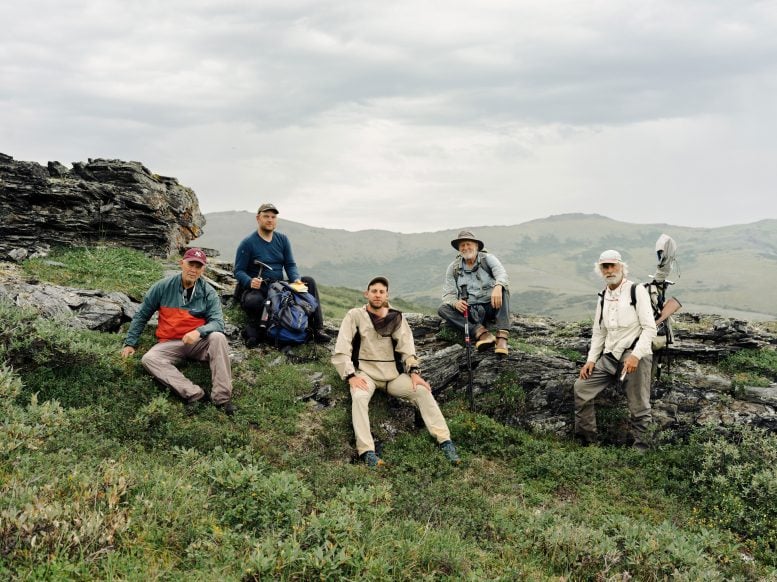
Warming soil releases toxic metals that threaten fish and disrupt food chains.
In Alaska’s Brooks Range, rivers that were once clear enough to drink have turned a murky orange as toxic metals spread through the water. Warming is thawing long-frozen ground, setting off chemical reactions that are harming fish and disrupting entire ecosystems.
As global temperatures rise, permafrost — permanently frozen Arctic soil that has stored minerals for thousands of years — is melting. Water and oxygen seep into newly exposed layers, breaking down sulfide-rich rock. This process produces sulfuric acid, which pulls naturally occurring metals such as iron, cadmium, and aluminum from the rock into the river.
Changes like these are often linked to mining activity. In this case, however, mining is not the cause.
“This is what acid mine drainage looks like,” said Tim Lyons, a biogeochemist at the University of California, Riverside. “But here, there’s no mine. The permafrost is thawing and changing the chemistry of the landscape.”

Scientific Alarms
A new paper detailing the severity of the contamination has been published in the Proceedings of the National Academy of Sciences. Though the study focuses on the Salmon River, researchers warn that similar transformations are already underway across dozens of other Arctic watersheds.
“I have worked and traveled in the Brooks Range since 1976, and the recent changes in landforms and water chemistry are truly astounding,” said David Cooper, Colorado State University research scientist and study co-author.
Ecologist Paddy Sullivan of the University of Alaska first noticed the dramatic changes in 2019 while conducting fieldwork on Arctic forests shifting northward — another consequence of climate change. A pilot flying Sullivan into the field warned him the Salmon River hadn’t cleared up after the snowmelt and looked “like sewage.” Alarmed by what he saw, Sullivan joined forces with Lyons, Roman Dial from Alaska Pacific University, and others to investigate the causes and ecological consequences.

Their analysis confirmed that thawing permafrost was unleashing geochemical reactions that oxidize sulfide-rich rocks like pyrite, generating acidity and mobilizing a wide suite of metals, including cadmium, which accumulates in fish organs and could affect animals like bears and birds that eat fish.
In small amounts, metals aren’t necessarily toxic. However, the study shows that levels of metals in the river’s waters exceed U.S. Environmental Protection Agency toxicity thresholds for aquatic life. In addition, the iron-clouded waters reduce the amount of light reaching the bottom of the river and smother insect larvae eaten by the salmon and other fish.
Ecological and Human Consequences
While current metal concentrations in edible fish tissue are not considered hazardous to humans, the changes to the rivers pose indirect but serious threats. Chum salmon, a key subsistence species for many Indigenous communities, might struggle to spawn in gravel beds choked with fine sediment. Other species, such as grayling and Dolly Varden, may also be affected.
“It’s not just a Salmon River story,” Lyons said. “This is happening across the Arctic. Wherever you have the right kind of rock and thawing permafrost, this process can start.”
Unlike mine sites, where acid drainage can be mitigated with buffers or containment systems, these remote watersheds might have hundreds of contamination sources and no such infrastructure. Once the chemical process begins, the only thing that can stop it is the recovery of the permafrost.
“There’s no fixing this once it starts,” Lyons said. “It’s another irreversible shift driven by a warming planet.”
The study, funded by the National Science Foundation’s Rapid Response program, highlights the potential danger for other Arctic regions. The researchers would like to help communities and land managers anticipate future impacts and, when possible, prepare for them.
“There are few places left on Earth as untouched as these rivers,” Lyons said. “But even here, far from cities and highways, the fingerprint of global warming is unmistakable. No place is spared.”
Reference: “Wild, scenic, and toxic: Recent degradation of an iconic Arctic watershed with permafrost thaw” by Patrick F. Sullivan, Roman J. Dial, David J. Cooper, Charles Diamond, Christopher J. Tino, Daniel D. Gregory, Russell E. Wong and Timothy W. Lyons, 8 September 2025, Proceedings of the National Academy of Sciences.
DOI: 10.1073/pnas.2425644122
Never miss a breakthrough: Join the SciTechDaily newsletter.
1 Comment
“Once the chemical process begins, the only thing that can stop it is the recovery of the permafrost.”
No. It will probably take a long time, but the pyrite (iron sulfide) that oxidizes and creates jarosite and ferrihydrite (and similar species of iron sulfates and hydroxides) responsible for the color will eventually be exhausted and quit contributing to the problem. Because the streams previously ran clear, that suggests that the pyrite had been decomposed down to the level of the permafrost. Although, what seems a little strange is that some of the deepest orange coloring appears to be gravel bars above the permafrost. There seems to be more to this issue than what we are reading. The researchers acknowledge this in the remark, “The 1975 Salmon River reconnaissance found that Paluqtaq carried “reddish, murky colored water”, further indicating that its degradation is NOT a result of recently enhanced sulfide mineral oxidation with permafrost thaw.”
Note that the authors of this paper actually use the term “acidification” correctly, unlike most climatologists and oceanographers. They leave little doubt in a reader’s mind as to exactly what they are doing when they refer to “acidification.”